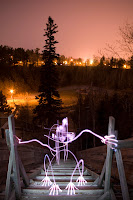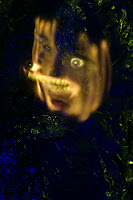The process of visualizing the photo can be just as fun as taking it. This is the first thing I do on my way and when I arrive to a location. Usually I am not working on a preconceived idea, so I make it up as I go. There are many factors to consider before you start shooting, and recognizing them is something you learn with time and mistakes.
Here are some questions I may ask myself about a location:
1. Is it dark enough?
Take note of any ambient light that may interfere with your image. What is the maximum exposure I can take before it becomes over exposed? Some light tools are bright enough to use in light polluted areas while others are not. Streetlights, buildings, cars, the moon, sun, reflections, and lots of other things can ruin a great composition. Of course, you can also use the ambient to your advantage. ----->

2. Is it safe?
Before I whip out all my investments, I like to be sure that it's alright to do so. Be aware of such dangers as snakes(they attack to kill), poison ivy, hobos, gangsters, rain, floods, cliffs, moisture, and anything else that will hamper your ability to think creatively or mess up your equipment.
3. Where should I set up?
I like to take the time to relax when I arrive. This allows me to become familiar with all the aspects of the area. Walk around and search for the best composition. Take some quick flash photos. Compare your options and make a decision.
4. What should I do?
So, now you have your camera on the tripod all ready to go. Now what? Your composition and bag of tricks will decide what happens. I like to step back and relax again at this point (I'm lazy). Look at your scene and imagine what could happen there. How does it make you feel? What brought you to this place? How do you belong there? Is this a good spot for a light creature or better suited for a woolspin? Be versatile enough to make the most out of it. If you can't come up with anything striking, just start doing something random. This almost always leads to new ideas. If still the area isn't working out, try some techniques that aren't dependent on the scene. Plenty of different, interesting photos can be taken anywhere it is dark. Have fun with it!

That's basically my thought process for flicking places I've never been to before. The energy of the unknown is something to seek. Allow your images to happen in a natural sequence.
 I feel like I'm cheating by making these shapes on a computer and then just taking a photo of the computer. I guess if it's all one exposure it's still better than using Photoshop. It was fun having my laptop in a tunnel, and I plan on doing it more.
I feel like I'm cheating by making these shapes on a computer and then just taking a photo of the computer. I guess if it's all one exposure it's still better than using Photoshop. It was fun having my laptop in a tunnel, and I plan on doing it more.





